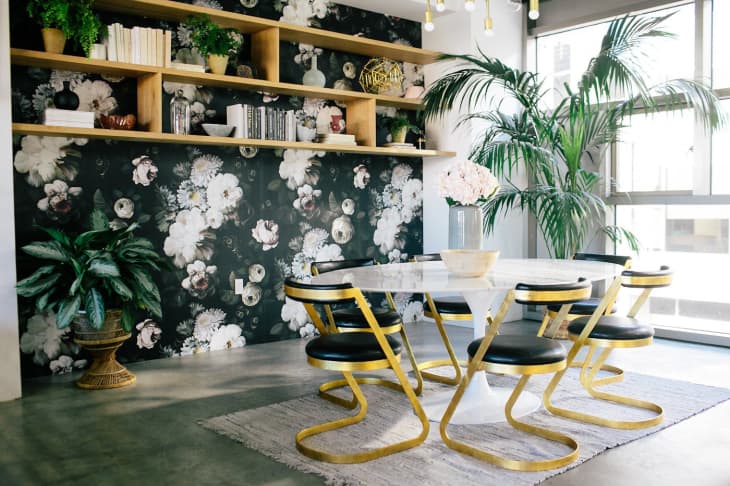Floral Print Trends Through the Decades

You can’t really go wrong with a floral accent or two in a room. Of course, they sometimes feel a little too saccharine, plus there’s crazy granny potential there, too. And you definitely don’t want to go overboard, unless you’re trying to live in a Liberty of London or Laura Ashley ad.
But generally speaking, a flower patterned pillow, chair, dish, piece of art—heck, wall covering or even carpet—can be a classic item that will have tons of decorative bang for your buck and staying power to boot. And around this time of year, there’s nothing better than bringing a little bit of floral whimsy into your home.
But floral motifs have actually evolved quite a bit over the years, and we thought it would be fun to travel down decorative memory lane a bit to see where florals have been, are now, and may be going in the design future.
1950s
Let’s start our history lesson in the ’50s. Floral drapery and upholstery were big during this decade. Many homes were decorated in an Early American style that harked back to the Colonial era—similar to what’s on this old magazine cover, which features a skirted floral sofa. By decade’s end, new styles started creeping in with the popularity of barkcloth fabrics, some of which sported floral meets Space Age, atomic motifs.
1960s
The stuffier, prim-and-proper florals, like the ’50s example above, became liberated in the era of “Flower Power.” Large-scale florals started trending in the ’60s, and you could find them on furniture and walls throughout homes, even in the kitchen. Quieter ditsy flower prints started gaining in popularity as well.
1970s
By the ’70s, things started getting super groovy in fashion and interiors. Think even bigger, bolder flowers in saturated colors, especially the big hues of the decade: Mustard, orange and avocado. On the whole, the flowers of this decade appear to be more stylized than realistic, which probably owes something to ’60s Pop Art influence.
1980s
The ’80s were definitely a time of excess, and the decade’s floral motifs were no exception to this rule. In fact, florals were used very liberally at this juncture in time—it wouldn’t be uncommon to see floral bedding, floral drapery, and floral wall coverings all in the same room. The more florals, the merrier. Of course, companies like Laura Ashley had been around for years already, but with the rise of chintz, cabbage roses, and mauve, that super feminine, English country look became super mainstream.
1990s
The ’90s saw the rise (and fortunately fall) of the silk flower phenomenon. Yes, fresh flowers have a limited lifespan, and houseplants can be finicky, but silk flowers literally just collect dust, even if they are “low-maintenance.” You can still find them in stores today, but they’re not these huge cheesy arrangements any more, thank goodness. And there’s definitely a difference between the paper flower craft movement happening now and the silk flower craze of the ’90s. All fake flowers are not created equal.
2000s
By the time the early 2000s rolled around, floral trends were kind of a mix of everything from decades past, which actually still feels like the case. Personally, I remember magnolias in particular having a moment in the late ’90s into the early ’00s. I’ll never forget the Waverly magnolia bedspread and wallpaper my mother bought for her master bedroom and en suite bathroom. Feast your eyes on this pattern, people (care of eBay).
2010s
In some way, that pattern (and others like it) was sort of a precursor to the dark photorealistic florals we’re seeing so much of today, from Ted Baker bedspreads to the dramatic wallpaper in this bedroom.
2010s
Of course, the Scandinavian craze we’re still in has made Marimekko and Josef Frank-style florals, like those above, a big deal these days.
The Future
Rifle Paper Co.‘s stylized floral patterns have made such an impact on our design psyche as well, and I don’t see that changing any time soon. So expect more of these illustrated florals in the years to come.
So now that we’ve basically been in a decorating time machine and examined florals from the ’50s forward, what are you glad we’ve left behind? And what styles do you think will make a comeback?